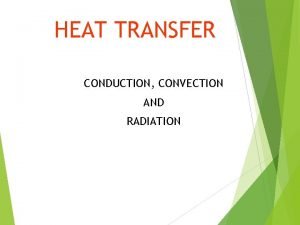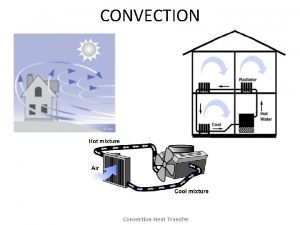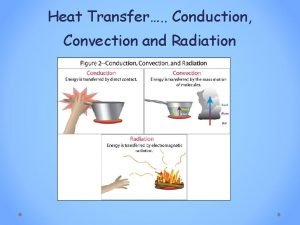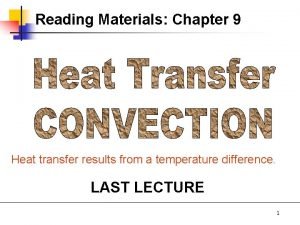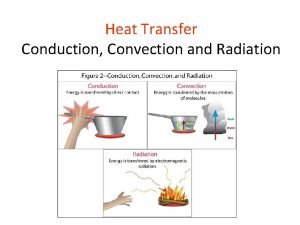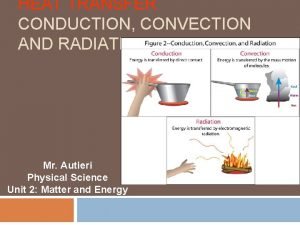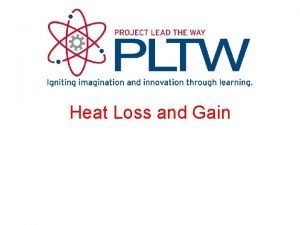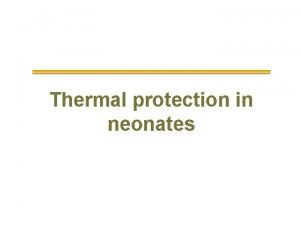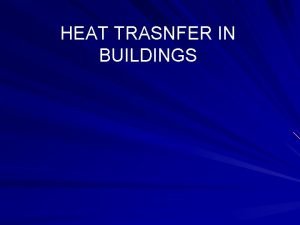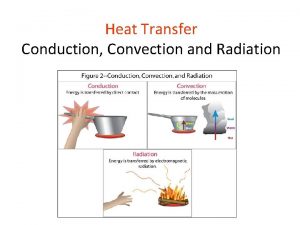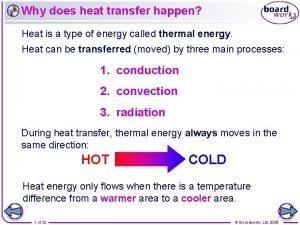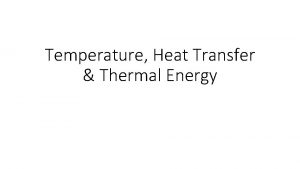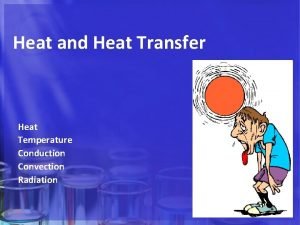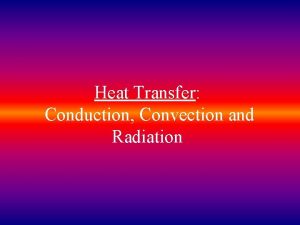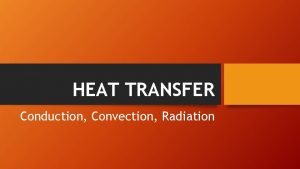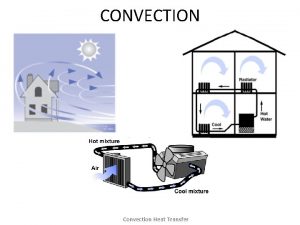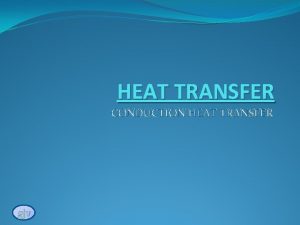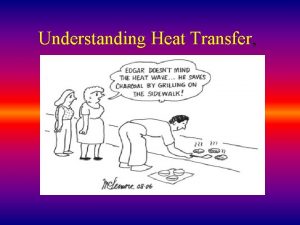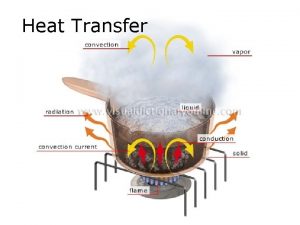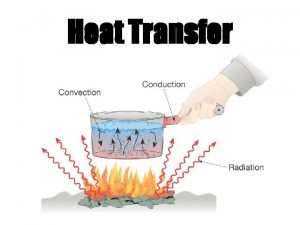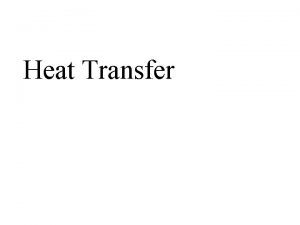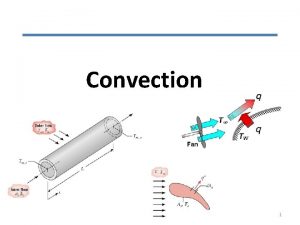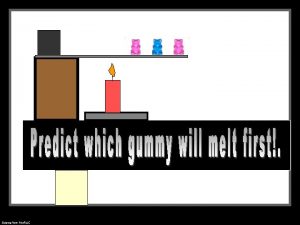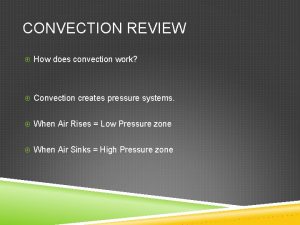Heat transfer Eric Angat Teacher Convection http www




















- Slides: 20

Heat transfer Eric Angat Teacher Convection: http: //www. youtube. com/watch? v=Ife. Ra. Ob_E-s Radiation: http: //www. youtube. com/watch? v=2 JZci. Wt. K 6 vc Conduction: http: //www. youtube. com/watch? v=9 jo. LYfayee 8

Essential Question How does heat transfer affect weather?

http: //www. deltat. com/ways_to_transfer_heat. html

Conduction happens fastest in metals. convection happens in fluids (liquids and gases). Hot fluids rise and cold fluids sinks Radiation is heat transfer by electromagnetic radiation. Radiation heat transfer can happen even in space. http: //www. johnsonwindowfilms. com/dealer/article. View. php? ARTICLE_ID=148 http: //okfirst. mesonet. org/train/meteorology/Heat. Transfer. html

Interactive Learning http: //www. pbslearningmedia. org/asset/lsps 07_int_heattransfer/

Radiation- heat travels in a vacuum. 1. What are three types of heat transfer? 2. How is heat similar to seismic energy? Think! 3. How is heat transferred from the Sun to you? The Sun is 93 million miles of empty space away from us. Think!

Radiation- heat travels in a vacuum. Radiation: http: //www. youtube. com/watch? v=2 JZci. Wt. K 6 vc

1. What are three types of heat transfer? Radiation, convection, and conduction 2. How is radiation heat transfer similar to seismic energy? Think! They are both waves. 3. How is heat transferred from the Sun to you? The Sun is 93 million miles of empty space away from us. Think! Because heat can travel in the form of electromagnetic wave.

convection – WARM AND MOIST air rises convection – http: //www. weatherquestions. com/What_is_convection COLD AND DRY air sinks

Warm: Carbon monoxide Convection – heat transfer in gases. Cold air (nitrogen, oxygen, and other gases) http: //www. nist. gov/fire_behavior. cfm

Convection – hot gases and liquids rise and cold gases and liquids sink. 4. What is bouyancy ? 5. What is convection? 6. Why is the furnace located in the basement and not in the attic? Think! 7. What happens to water and air when heated? 8. What are fluids?

Convection means hot gases and liquids rise and cold gases and liquids sink. Convection: http: //www. youtube. com/watch? v=Ife. Ra. Ob_E-s Fluids refer to liquids and gases.

4. What is buoyancy ? Buoyancy states that if an object is denser it sinks and when it is less dense it rises. 5. What is convection? Convection means hot gases and liquids rise and cold gases and liquids sink. 6. Why is the furnace located in the basement and not in the attic? Think! Because of convection. If the furnace is in the attic then the basement will be freezing.

7. What happens to water and air when heated? When water and air are heated they become Less dense and they rise. 8. What are fluids? Fluids refer to liquids and gases.

Conduction is the transfer of heat by colliding particles. 9. Which is a better conductor metal or glass? 10. Why are metals considered as the best conductors? 11. What is conduction?

Conduction is the transfer of heat by colliding particles. Metals have free electrons making them the best conductors. Conduction: http: //www. youtube. com/watch? v=9 jo. LYfayee 8

9. Which is a better conductor metal or glass? metal 10. Why are metals considered as the best conductors? Because metals have free electrons. 11. What is conduction? Conduction is the transfer of heat by colliding particles

A. Conduction B. convection C. radiation ______12. This type of heat transfer causes tectonic plates to move. ______13. boiling water. ______14. evaporation. ______15. Wind. ______16. moves as a electromagnetic wave. ______17. occurs with fluids. ______18. handle of a pot getting hotter. ______19. warm water and air rises from the equator. ______20. cold water and wind sinks from Canada.

A. Conduction B. convection C. radiation? B. convection ______12. This type of heat transfer causes tectonic plates to move. B. convection ______13. boiling water. ______14. evaporation. B. convection ______15. Wind. B. convection C. radiation ______16. moves as a electromagnetic wave. ______17. occurs with fluids. B. convection A. conduction ______18. handle of a cooking pot getting hotter. ______19. warm water and air rises from the B. convection equator. B. convection ______20. cold water and wind sinks from Canada.

B 21. Heat transfer in liquids and gases. C 22. Heat transfer without the need of a medium ( solid, liquid, gas). A 24. Flow of heat by physical contact. B 25. Heat transfer in fluids. C 26. Heat transfer through space. C 27. Sunlight travels 93 million miles to reach earth. B 28. Warm air mass from the Gulf of Mexico rises towards the East coast. B 29. Cold air mass from the North sinks towards the East coast. A 30. The engine of the car is very hot. A 31. In the beach, the sand becomes very hot during summer. B 32. Warm air has more water vapor than cold air.
 Mtpdp
Mtpdp What is heat transfer conduction convection and radiation
What is heat transfer conduction convection and radiation What is heat transfer conduction convection and radiation
What is heat transfer conduction convection and radiation Convection formula
Convection formula Radiation travels in straight line. (true/false)
Radiation travels in straight line. (true/false) Convection heat transfer
Convection heat transfer What is convection
What is convection Radiation convection conduction
Radiation convection conduction Convection heat transfer
Convection heat transfer Newborn convection heat loss
Newborn convection heat loss What is the heat source for convection currents
What is the heat source for convection currents What is heat trasnfer
What is heat trasnfer 5 examples that involve heat transfer through radiation
5 examples that involve heat transfer through radiation Erf promotion for teachers
Erf promotion for teachers Good morning students
Good morning students A repeating disturbance that transfers energy
A repeating disturbance that transfers energy Http://teacher.scholastic.com/activities/immigration/tour/
Http://teacher.scholastic.com/activities/immigration/tour/ Heat transfer of metals
Heat transfer of metals What is unit of viscosity
What is unit of viscosity Heat energy transfer
Heat energy transfer Example of heat energy
Example of heat energy


